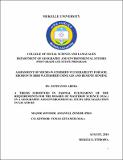| dc.description.abstract | The major objective of this study is assessment of the most erosion vulnerable micro-watersheds in Ribb watershed. This is because it is difficult to launch soil and water conservation and other environmental protection projects in all micro-watershed at the same time. So, the most erosion vulnerable micro-watersheds have to be identified. In this study Revised Universal Soil Loss Equation (RUSLE) and Multi-criteria Analysis (MCA) have been applied to quantify the soil erosion risk and identify the most vulnerable micro-watersheds. For this remotely sensed data and other ancillary data in GIS and remote sensing techniques are used. To assess the potential gully areas Topographic threshold concept are used. From The result of RUSLE model the potential average annual soil loss of the micro-watersheds ranges from 10.93 to 95.5 t/ha/year with a mean annual soil loss of 39.8 t/ha/year. The upper five micro-watersheds (MW-16, MW-23, MW-26, MW-27 and MW-29) covering 17.6% of the watershed shows very high mean soil loss rate. In the high mean soil erosion rate classes there are three MWs (MW-3, MW-18 and MW-20) and it covers 8.28% of the study area. Thus, they are above the annual average soil loss of the entire watershed (39.8 ton/ha/year). These micro watersheds under high and very high class demand immediate attention in terms of management and planning perspective. From the total area of the watershed which is 1240.12 km2, 92 km2 are potential areas for gully development. Based on the MCA, the micro- watersheds 3, 16, 23, 26 and 27 covering 19.47% of the study area have a Very high CEI and the largest portion (27.61%) of the study area is under high class of CEI and it includes seven Micro-watersheds. Thus these micro-watersheds are more vulnerable to erosion compared to the others and these needs immediate action. Considering the result of RUSLE model and MCA from the slope, gully, land cover and soil factors, micro-watersheds with large value of mean soil loss rate and CEI value are more soil erosion vulnerable micro- watersheds. Thus they should be prioritized for conservation and other environmental protection activities. | en_GB |


